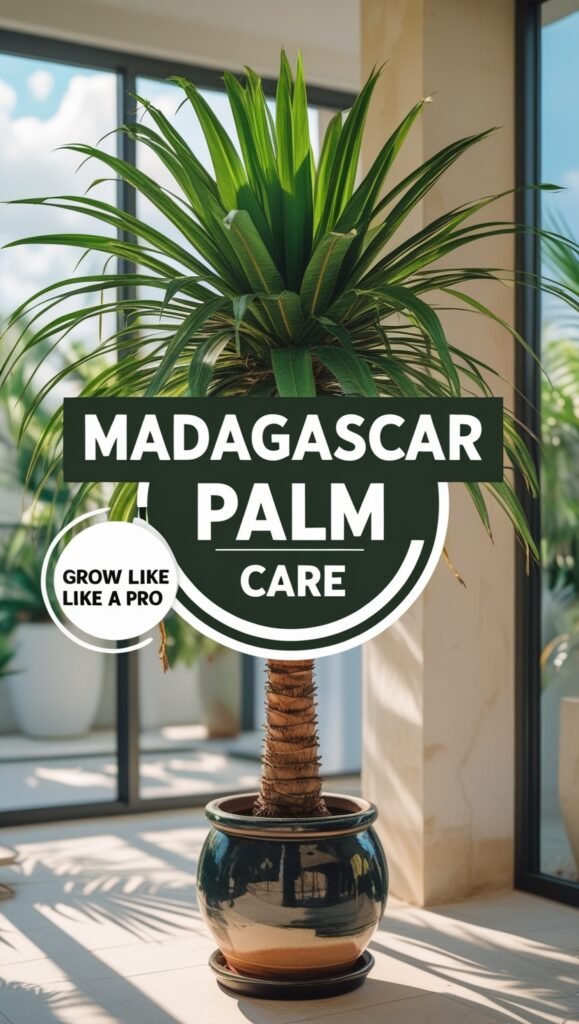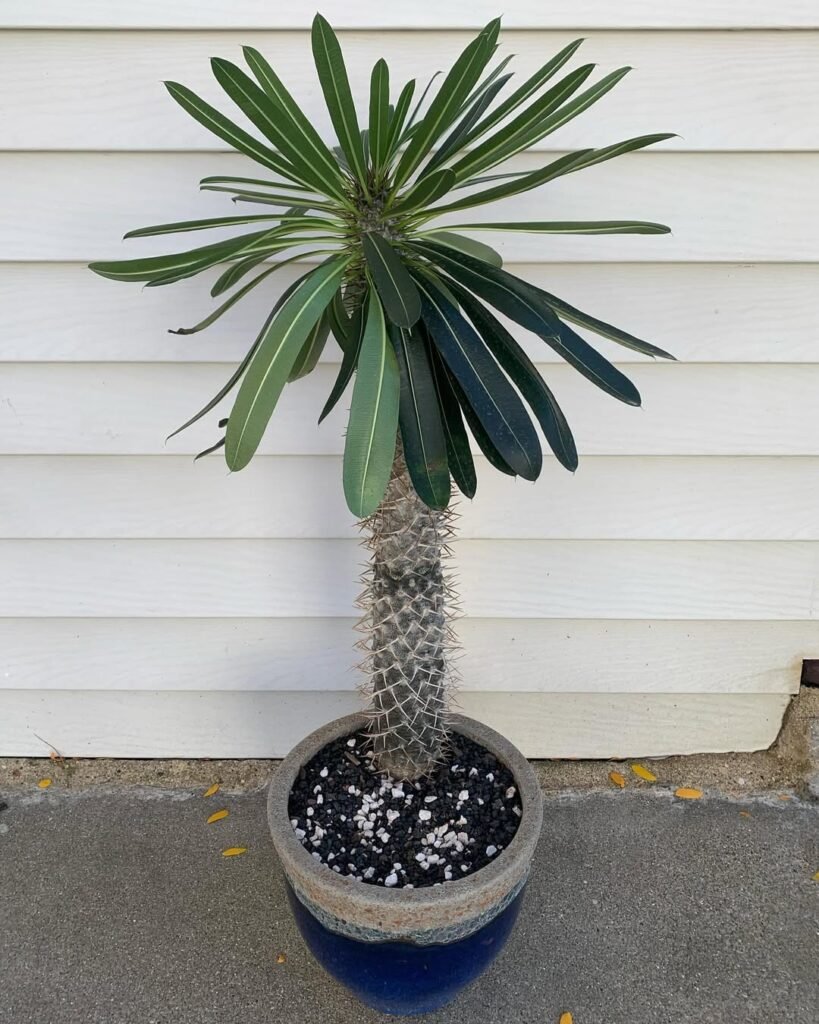Learn how to care for your Madagascar palm with our expert guide. Discover watering, light, soil, and winter care tips for this unique succulent.

When I bought my first Madagascar palm ten years ago, I nearly killed it with kindness. I watered it like my other tropical plants, not realizing this spiky beauty prefers neglect. After weeks of research and consulting with expert growers, I discovered the Madagascar palm isn’t a palm at all, but a succulent with completely different needs.
If you want to master Madagascar palm care, you have come to the right place. In this comprehensive guide, I will share everything I have learned about keeping these striking plants healthy indoors and outdoors.
What Exactly is a Madagascar Palm?

The Madagascar palm (Pachypodium lamerei) looks like a palm tree with its tall trunk and crown of leaves, but it is actually a succulent member of the Apocynaceae family. Native to the island of Madagascar off the southeastern coast of Africa, this plant has adapted to survive in semi-arid conditions .
You can identify this plant by these key features:
- Thick, grey trunk that serves as a water reservoir, similar to cacti
- Protective spines covering the trunk that can puncture skin
- Shiny, dark green leaves that form a crown at the top of the plant
- Fragrant white flowers that appear in summer on mature plants
Despite its name, this plant is more closely related to cacti than palms, which explains its unique care requirements.
Essential Madagascar Palm Care Requirements
Understanding these core needs will help you create the perfect environment for your plant to thrive.
Light and Temperature
Madagascar palms love sunlight. Aim to provide at least 6 hours of direct sunlight daily. Place indoor plants near a south-facing window for optimal light exposure. In extremely hot climates like Arizona, some afternoon shade can prevent leaf scorch.
These plants prefer temperatures between 70°F and 90°F (21°C – 32°C). They cannot tolerate frost, so bring them indoors if temperatures drop below 50°F (10°C). If you are growing Madagascar palm care outdoor in marginal climates, plant them in containers so you can move them indoors during colder months.
Watering Schedule
Proper watering is the most challenging aspect of Madagascar palm care. As a succulent, it stores water in its trunk and is highly susceptible to root rot from overwatering.
Follow these guidelines:
- Water thoroughly but infrequently, allowing the soil to dry out completely between waterings
- Reduce watering significantly in winter when the plant is dormant
- Use the soak-and-dry method: water deeply until it drains from the bottom, then do not water again until the soil is completely dry
The exact watering frequency depends on your climate, but typically ranges from every 2-3 weeks in summer to once a month or less in winter.
Soil and Potting
Madagascar palm care in pots requires fast-draining soil. Use a commercial cactus or succulent mix, or create your own with regular potting soil amended with sand, perlite, or pumice.
Ensure your container has:
- Adequate drainage holes to prevent water retention
- Sufficient weight to support this top-heavy plant; clay or ceramic pots work well
- Appropriate size that accommodates the root system without being excessively large
Repot your Madagascar palm plant care every 2-3 years or when it becomes root-bound. Always wear protective gloves when handling to avoid the sharp spines.
Fertilizing
Feed your Madagascar palm during its growing season (spring and summer) with a balanced, water-soluble fertilizer diluted to half strength. Apply every 2-4 weeks. Do not fertilize in fall and winter when the plant is dormant.
Seasonal Care Guide
Madagascar Palm Care in Winter
Winter is a dormant period for these plants. Your Madagascar palm care in winter should include:
- Reduced watering – only enough to prevent shriveling
- No fertilizer until spring
- Cooler temperatures between 55-65°F if possible
- Bright light continues to be essential
Do not be alarmed if your plant loses some leaves during this period; this is normal dormancy behavior .
Growing Season Care
In spring and summer, your Madagascar palm enters its active growth phase. During this time:
- Resume regular watering when the soil dries out
- Begin fertilizing to support new growth
- Monitor for pests like mealybugs and spider mites
- Consider moving outdoors to a sunny patio if temperatures permit
With proper care, you can expect 6-12 inches of growth per year during the growing season.
Troubleshooting Common Problems
Even with excellent care, issues can arise. Here is how to address them:
- Yellowing leaves: Usually caused by overwatering. Allow soil to dry completely between waterings
- Leaf drop: Can result from sudden temperature changes, underwatering, or natural dormancy. Check growing conditions and adjust as needed
- Soft or mushy stem: Indicates root rot from overwatering. You may need to repot in fresh, dry soil and trim affected roots
- Brown or black spots on leaves: Could be fungal issues from high humidity or sunburn from sudden light exposure
- Stunted growth: Often due to insufficient light, poor soil nutrition, or being root-bound
How to Propagate Madagascar Palm
You can create new plants through two main methods:
Propagation from Seeds
- Collect seed pods from a mature plant and let them dry for 1-4 weeks
- Soak seeds in non-chlorinated water for 24 hours
- Plant in cactus soil and keep warm (75-85°F)
- Be patient – germination can take from 3 weeks to 6 months
Propagation from Cuttings
- Take a healthy stem cutting at least 3-4 inches long using clean, sharp pruners
- Let the cutting callous for 4-8 days in a dry, warm place
- Plant in fast-draining soil
- Water lightly and provide bright, indirect light until roots establish
Propagation from cuttings is generally more successful than from seeds for home gardeners.
Safety Considerations
The Madagascar palm contains a toxic sap that can irritate skin and is poisonous if ingested. The spines along the trunk can also puncture skin.
To handle your plant safely:
- Wear thick gloves when repotting or pruning
- Wash hands thoroughly after handling the plant
- Keep away from children and pets who might touch or ingest it
- Be cautious of the spines when moving the plant
Indoor vs. Outdoor Care
Madagascar palm care indoor requires attention to light sources. Rotate your plant regularly to prevent it from growing crooked as it reaches for light. You may need to supplement with grow lights in darker spaces.
For Madagascar palm care outdoor in warm climates, plant in well-draining soil and provide full sun. In areas like Arizona, provide some afternoon shade during extreme heat.
Quick Care Table
| Care Aspect | Requirements |
|---|---|
| Light | Full sun (6+ hours daily) |
| Water | Allow soil to dry completely between waterings |
| Soil | Well-draining cactus/succulent mix |
| Temperature | 70-90°F (21-32°C); not below 50°F (10°C) |
| Fertilizer | Balanced, diluted fertilizer in spring/summer |
| Toxicity | Toxic sap; handle with care |
Final Thoughts
Mastering Madagascar palm care instructions requires understanding that this plant thrives on neglect rather than constant attention. Provide plenty of sunlight, well-draining soil, and infrequent watering, and your spiky friend will reward you with years of unique beauty.
If you found this guide helpful, you might also enjoy my articles on other drought-tolerant succulents and low-maintenance houseplants for busy gardeners.
For further reading, I recommend these authoritative resources:
- Royal Horticultural Society for general plant care advice
- University of Florida IFAS Extension for scientific growing information
- USDA Plant Hardiness Zone Map to determine your growing zone
- Missouri Botanical Garden for plant database information
- Cactus and Succulent Society of America for specialized care tips
Remember, the key to successful Madagascar palm plant care is mimicking its natural dry habitat. With these tips, you can enjoy this exotic beauty for years to come.




